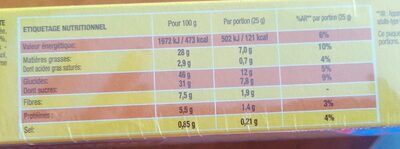Help us make food transparency the norm!
As a non-profit organization, we depend on your donations to continue informing consumers around the world about what they eat.
The food revolution starts with you!
Lot 2 pocket x7 cacao nois 175g - Brossard - 350 g
Lot 2 pocket x7 cacao nois 175g - Brossard - 350 g
This product page is not complete. You can help to complete it by editing it and adding more data from the photos we have, or by taking more photos using the app for Android or iPhone/iPad. Thank you!
×
Some of the data for this product has been provided directly by the manufacturer JACQUET BROSSARD DISTRIBUTION.
Barcode: 3660140936309 (EAN / EAN-13)
Common name: Gâteaux avec fourrage au cacao maigre et à la noisette, aromatisé noisette
Quantity: 350 g
Packaging: Box
Brands: Brossard
Categories: Snacks, Sweet snacks, Biscuits and cakes, Cakes, Chocolate cakes
Labels, certifications, awards: Made in France, No palm oil, Nutriscore, Nutriscore Grade D
Countries where sold: France
Matching with your preferences
Health
Ingredients
-
26 ingredients
: Sucre, huiles et graisses végétales : colza - palme - tournesol, OEUFS frais, farine de BLÉ 19,2%, stabilisant : glycérol, NOISETTES 2,5%, LAIT écrémé en poudre, sirop de glucose-fructose, gomme d'acacia (fibre soluble), cacao maigre en poudre 1,1%, poudres à lever : diphosphates - carbonates de sodium, conservateur : sorbate de potassium, fibres de BLÉ, sel, gélifiant : gomme xanthane, émulsifiant : lécithines de SOJA, arôme.Allergens: Eggs, Gluten, Milk, Nuts, SoybeansTraces: Nuts, Peanuts
Food processing
-
Ultra processed foods
Elements that indicate the product is in the 4 - Ultra processed food and drink products group:
- Additive: E322 - Lecithins
- Additive: E414 - Acacia gum
- Additive: E415 - Xanthan gum
- Additive: E422 - Glycerol
- Additive: E450 - Diphosphates
- Ingredient: Emulsifier
- Ingredient: Flavouring
- Ingredient: Gelling agent
- Ingredient: Glucose
Food products are classified into 4 groups according to their degree of processing:
- Unprocessed or minimally processed foods
- Processed culinary ingredients
- Processed foods
- Ultra processed foods
The determination of the group is based on the category of the product and on the ingredients it contains.
Additives
-
E202 - Potassium sorbate
Potassium sorbate (E202) is a synthetic food preservative commonly used to extend the shelf life of various food products.
It works by inhibiting the growth of molds, yeast, and some bacteria, preventing spoilage. When added to foods, it helps maintain their freshness and quality.
Some studies have shown that when combined with nitrites, potassium sorbate have genotoxic activity in vitro. However, potassium sorbate is generally recognized as safe (GRAS) by regulatory authorities.
-
E322 - Lecithins
Lecithins are natural compounds commonly used in the food industry as emulsifiers and stabilizers.
Extracted from sources like soybeans and eggs, lecithins consist of phospholipids that enhance the mixing of oil and water, ensuring smooth textures in various products like chocolates, dressings, and baked goods.
They do not present any known health risks.
-
E322i - Lecithin
Lecithins are natural compounds commonly used in the food industry as emulsifiers and stabilizers.
Extracted from sources like soybeans and eggs, lecithins consist of phospholipids that enhance the mixing of oil and water, ensuring smooth textures in various products like chocolates, dressings, and baked goods.
They do not present any known health risks.
-
E414 - Acacia gum
Gum arabic: Gum arabic, also known as acacia gum, arabic gum, gum acacia, acacia, Senegal gum and Indian gum, and by other names, is a natural gum consisting of the hardened sap of various species of the acacia tree. Originally, gum arabic was collected from Acacia nilotica which was called the "gum arabic tree"; in the present day, gum arabic is collected from acacia species, predominantly Acacia senegal and Vachellia -Acacia- seyal; the term "gum arabic" does not indicate a particular botanical source. In a few cases so‐called "gum arabic" may not even have been collected from Acacia species, but may originate from Combretum, Albizia or some other genus. Producers harvest the gum commercially from wild trees, mostly in Sudan -80%- and throughout the Sahel, from Senegal to Somalia—though it is historically cultivated in Arabia and West Asia. Gum arabic is a complex mixture of glycoproteins and polysaccharides. It is the original source of the sugars arabinose and ribose, both of which were first discovered and isolated from it, and are named after it. Gum arabic is soluble in water. It is edible, and used primarily in the food industry as a stabilizer, with EU E number E414. Gum arabic is a key ingredient in traditional lithography and is used in printing, paint production, glue, cosmetics and various industrial applications, including viscosity control in inks and in textile industries, though less expensive materials compete with it for many of these roles. While gum arabic is now produced throughout the African Sahel, it is still harvested and used in the Middle East.Source: Wikipedia
-
E415 - Xanthan gum
Xanthan gum (E415) is a natural polysaccharide derived from fermented sugars, often used in the food industry as a thickening and stabilizing agent.
This versatile food additive enhances texture and prevents ingredient separation in a wide range of products, including salad dressings, sauces, and gluten-free baked goods.
It is considered safe for consumption even at high intake amounts.
-
E422 - Glycerol
Glycerol: Glycerol -; also called glycerine or glycerin; see spelling differences- is a simple polyol compound. It is a colorless, odorless, viscous liquid that is sweet-tasting and non-toxic. The glycerol backbone is found in all lipids known as triglycerides. It is widely used in the food industry as a sweetener and humectant and in pharmaceutical formulations. Glycerol has three hydroxyl groups that are responsible for its solubility in water and its hygroscopic nature.Source: Wikipedia
-
E450 - Diphosphates
Diphosphates (E450) are food additives often utilized to modify the texture of products, acting as leavening agents in baking and preventing the coagulation of canned food.
These salts can stabilize whipped cream and are also found in powdered products to maintain their flow properties. They are commonly present in baked goods, processed meats, and soft drinks.
Derived from phosphoric acid, they're part of our daily phosphate intake, which often surpasses recommended levels due to the prevalence of phosphates in processed foods and drinks.
Excessive phosphate consumption is linked to health issues, such as impaired kidney function and weakened bone health. Though diphosphates are generally regarded as safe when consumed within established acceptable daily intakes, it's imperative to monitor overall phosphate consumption to maintain optimal health.
-
E500 - Sodium carbonates
Sodium carbonates (E500) are compounds commonly used in food preparation as leavening agents, helping baked goods rise by releasing carbon dioxide when they interact with acids.
Often found in baking soda, they regulate the pH of food, preventing it from becoming too acidic or too alkaline. In the culinary world, sodium carbonates can also enhance the texture and structure of foods, such as noodles, by modifying the gluten network.
Generally recognized as safe, sodium carbonates are non-toxic when consumed in typical amounts found in food.
Ingredients analysis
-
Palm oil
Ingredients that contain palm oil: Palm
-
Non-vegan
Non-vegan ingredients: Fresh egg, Skimmed milk powder
-
Vegetarian status unknown
Unrecognized ingredients: Soluble fibre
-
Details of the analysis of the ingredients
: Sucre, huiles et graisses végétales de colza, palme, tournesol, OEUFS frais, farine de BLÉ 19.2%, stabilisant (glycérol), NOISETTES 2.5%, LAIT écrémé en poudre, sirop de glucose-fructose, gomme d'acacia (fibre soluble), cacao maigre en poudre 1.1%, poudres à lever (diphosphates), carbonates de sodium, conservateur (sorbate de potassium), fibres de BLÉ, sel, gélifiant (gomme xanthane), émulsifiant (lécithines de SOJA), arôme- Sucre -> en:sugar - vegan: yes - vegetarian: yes - ciqual_proxy_food_code: 31016
- huiles et graisses végétales de colza -> en:colza-oil - vegan: yes - vegetarian: yes - from_palm_oil: no - ciqual_food_code: 17130
- palme -> en:palm - vegan: yes - vegetarian: yes - from_palm_oil: yes - ciqual_food_code: 16129
- tournesol -> en:sunflower - vegan: yes - vegetarian: yes
- OEUFS frais -> en:fresh-egg - vegan: no - vegetarian: yes - ciqual_food_code: 22000
- farine de BLÉ -> en:wheat-flour - vegan: yes - vegetarian: yes - ciqual_proxy_food_code: 9410 - percent: 19.2
- stabilisant -> en:stabiliser
- glycérol -> en:e422 - vegan: maybe - vegetarian: maybe
- NOISETTES -> en:hazelnut - vegan: yes - vegetarian: yes - ciqual_food_code: 15004 - percent: 2.5
- LAIT écrémé en poudre -> en:skimmed-milk-powder - vegan: no - vegetarian: yes - ciqual_food_code: 19054
- sirop de glucose-fructose -> en:glucose-fructose-syrup - vegan: yes - vegetarian: yes - ciqual_food_code: 31077
- gomme d'acacia -> en:e414 - vegan: yes - vegetarian: yes
- fibre soluble -> en:soluble-fibre
- cacao maigre en poudre -> en:fat-reduced-cocoa-powder - vegan: yes - vegetarian: yes - ciqual_food_code: 18100 - percent: 1.1
- poudres à lever -> en:raising-agent
- diphosphates -> en:e450 - vegan: yes - vegetarian: yes
- carbonates de sodium -> en:e500 - vegan: yes - vegetarian: yes
- conservateur -> en:preservative
- sorbate de potassium -> en:e202 - vegan: yes - vegetarian: yes
- fibres de BLÉ -> en:wheat-fiber - vegan: yes - vegetarian: yes
- sel -> en:salt - vegan: yes - vegetarian: yes - ciqual_food_code: 11058
- gélifiant -> en:gelling-agent
- gomme xanthane -> en:e415 - vegan: yes - vegetarian: yes
- émulsifiant -> en:emulsifier
- lécithines de SOJA -> en:soya-lecithin - vegan: yes - vegetarian: yes - ciqual_food_code: 42200
- arôme -> en:flavouring - vegan: maybe - vegetarian: maybe
Nutrition
-
Poor nutritional quality
⚠ ️Warning: the amount of fruits, vegetables and nuts is not specified on the label, it was estimated from the list of ingredients: 27This product is not considered a beverage for the calculation of the Nutri-Score.
Positive points: 5
- Proteins: 3 / 5 (value: 5.5, rounded value: 5.5)
- Fiber: 5 / 5 (value: 7.5, rounded value: 7.5)
- Fruits, vegetables, nuts, and colza/walnut/olive oils: 0 / 5 (value: 27.5, rounded value: 27.5)
Negative points: 16
- Energy: 5 / 10 (value: 1979, rounded value: 1979)
- Sugars: 6 / 10 (value: 31, rounded value: 31)
- Saturated fat: 2 / 10 (value: 2.9, rounded value: 2.9)
- Sodium: 3 / 10 (value: 340, rounded value: 340)
The points for proteins are not counted because the negative points are greater or equal to 11.
Nutritional score: (16 - 5)
Nutri-Score:
-
Nutrient levels
-
Fat in high quantity (28%)
What you need to know- A high consumption of fat, especially saturated fats, can raise cholesterol, which increases the risk of heart diseases.
Recommendation: Limit the consumption of fat and saturated fat- Choose products with lower fat and saturated fat content.
-
Saturated fat in moderate quantity (2.9%)
What you need to know- A high consumption of fat, especially saturated fats, can raise cholesterol, which increases the risk of heart diseases.
Recommendation: Limit the consumption of fat and saturated fat- Choose products with lower fat and saturated fat content.
-
Sugars in high quantity (31%)
What you need to know- A high consumption of sugar can cause weight gain and tooth decay. It also augments the risk of type 2 diabetes and cardio-vascular diseases.
Recommendation: Limit the consumption of sugar and sugary drinks- Sugary drinks (such as sodas, fruit beverages, and fruit juices and nectars) should be limited as much as possible (no more than 1 glass a day).
- Choose products with lower sugar content and reduce the consumption of products with added sugars.
-
Salt in moderate quantity (0.85%)
What you need to know- A high consumption of salt (or sodium) can cause raised blood pressure, which can increase the risk of heart disease and stroke.
- Many people who have high blood pressure do not know it, as there are often no symptoms.
- Most people consume too much salt (on average 9 to 12 grams per day), around twice the recommended maximum level of intake.
Recommendation: Limit the consumption of salt and salted food- Reduce the quantity of salt used when cooking, and don't salt again at the table.
- Limit the consumption of salty snacks and choose products with lower salt content.
-
-
Nutrition facts
Nutrition facts As sold
for 100 g / 100 mlCompared to: Chocolate cakes Energy 1,979 kj
(473 kcal)+11% Fat 28 g +24% Saturated fat 2.9 g -63% Carbohydrates 46 g -7% Sugars 31 g - Fiber 7.5 g +161% Proteins 5.5 g -4% Salt 0.85 g +67% Fruits‚ vegetables‚ nuts and rapeseed‚ walnut and olive oils (estimate from ingredients list analysis) 27.5 %
Environment
-
Eco-Score D - High environmental impact
⚠ ️Select a country in order to include the full impact of transportation.The Eco-Score is an experimental score that summarizes the environmental impacts of food products.→ The Eco-Score was initially developped for France and it is being extended to other European countries. The Eco-Score formula is subject to change as it is regularly improved to make it more precise and better suited to each country.Life cycle analysis
-
Average impact of products of the same category: C (Score: 47/100)
Category: Chocolate cake
Category: Chocolate cake
- PEF environmental score: 0.60 (the lower the score, the lower the impact)
- including impact on climate change: 7.88 kg CO2 eq/kg of product
Stage Impact Agriculture
48.2 %Processing
45.1 %Packaging
3.2 %Transportation
2.7 %Distribution
0.8 %Consumption
0.0 %
Bonuses and maluses
-
Missing origins of ingredients information
Malus: -5
⚠ ️ The origins of the ingredients of this product are not indicated.
If they are indicated on the packaging, you can modify the product sheet and add them.
If you are the manufacturer of this product, you can send us the information with our free platform for producers.
-
Ingredients that threatens species
Malus: -10
Contains palm oil
Tropical forests in Asia, Africa and Latin America are destroyed to create and expand oil palm tree plantations. The deforestation contributes to climate change, and it endangers species such as the orangutan, the pigmy elephant and the Sumatran rhino.
-
Packaging with a medium impact
Malus: -10
Shape Material Recycling Impact Box Unknown High ⚠ ️ The information about the packaging of this product is not sufficiently precise (exact shapes and materials of all components of the packaging).⚠ ️ For a more precise calculation of the Eco-Score, you can modify the product page and add them.
If you are the manufacturer of this product, you can send us the information with our free platform for producers.
Eco-Score for this product
-
Impact for this product: D (Score: 22/100)
Product: Lot 2 pocket x7 cacao nois 175g - Brossard - 350 g
Life cycle analysis score: 47
Sum of bonuses and maluses: -25
Final score: 22/100
-
Carbon footprint
-
Equal to driving 4.1 km in a petrol car
788 g CO² per 100g of product
The carbon emission figure comes from ADEME's Agribalyse database, for the category: Chocolate cake (Source: ADEME Agribalyse Database)
Stage Impact Agriculture
30.6 %Processing
63.3 %Packaging
3.7 %Transportation
2.2 %Distribution
0.2 %Consumption
0.0 %
Packaging
-
Packaging with a medium impact
-
Packaging parts
Box
-
Packaging materials
Material % Packaging weight Packaging weight per 100 g of product
-
Transportation
-
Origins of ingredients
Missing origins of ingredients information
⚠ ️ The origins of the ingredients of this product are not indicated.
If they are indicated on the packaging, you can modify the product sheet and add them.
If you are the manufacturer of this product, you can send us the information with our free platform for producers.Add the origins of ingredients for this product Add the origins of ingredients for this product
Threatened species
-
Contains palm oil
Drives deforestation and threatens species such as the orangutan
Tropical forests in Asia, Africa and Latin America are destroyed to create and expand oil palm tree plantations. The deforestation contributes to climate change, and it endangers species such as the orangutan, the pigmy elephant and the Sumatran rhino.
Other information
Customer service: service conseil consommateur, Biopole - Clermont Limagne 63360 - Saint Beauzire
Report a problem
-
Incomplete or incorrect information?
Category, labels, ingredients, allergens, nutritional information, photos etc.
If the information does not match the information on the packaging, please complete or correct it. Open Food Facts is a collaborative database, and every contribution is useful for all.
Data sources
The manufacturer JACQUET BROSSARD DISTRIBUTION uses Equadis to automatically transmit data and photos for its products.
Product added on by kiliweb
Last edit of product page on by alexfauquette.
Product page also edited by moon-rabbit, openfoodfacts-contributors, org-jacquet-brossard-distribution, packbot, roboto-app, yuka.RjZrUUMvVWxqUGtscDhkdXdrUDd3T29vNUlYNFhYbTdkY2MzSVE9PQ.








